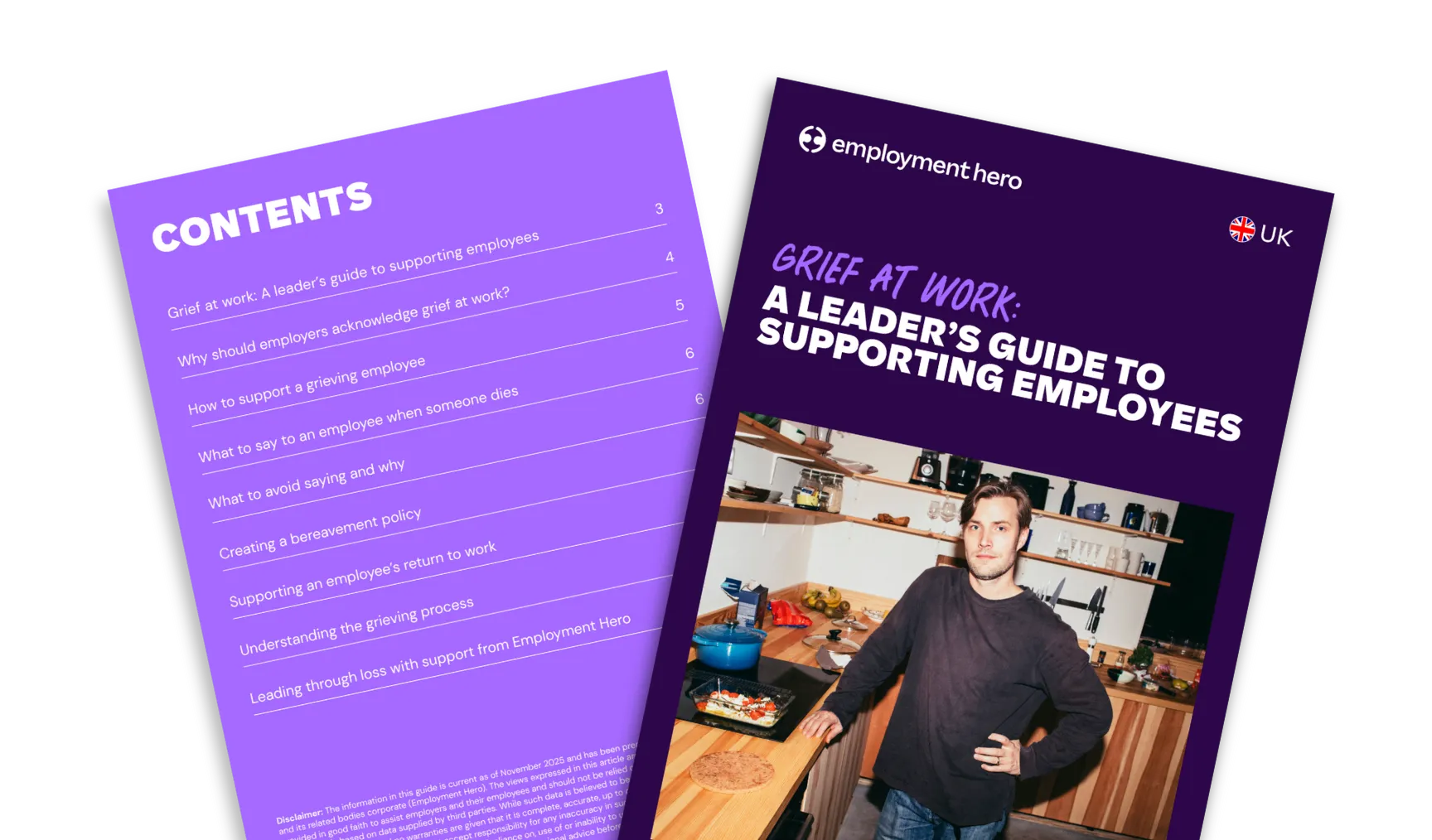Adoption leave and pay in the UK: an employer’s guide
Published
Adoption leave and pay in the UK: an employer’s guide
Published
When an employee welcomes a child through adoption, it’s one of the most significant moments of their life. As an employer, your role in supporting them through this transition is vital. Understanding adoption leave and pay isn’t just about legal compliance, it’s about building a workplace where every kind of family feels valued and supported.
What is in this guide?
This guide explains everything employers need to know about adoption leave in the UK. You’ll learn who qualifies, how to manage pay, what notice periods apply, and how to stay compliant with statutory requirements. It also covers related topics such as surrogacy arrangements, employee rights during leave, and how to make your workplace inclusive for adoptive parents.
Whether you’re updating your leave policy or handling your first adoption leave request, this guide will help you approach it with confidence, care and compliance.
What is adoption leave?
Adoption leave allows an employee to take time off work to bond with a child they are adopting. It exists to provide stability and time for family life to begin, similar to maternity leave. During this period, the employee’s job is protected and they may be entitled to Statutory Adoption Pay.
The entitlement applies when an employee is matched with a child through a UK adoption agency or when adopting from overseas. For fostering-to-adopt arrangements, leave can also begin when the child is placed with the employee under that scheme.
Only one person in a couple can take adoption leave, but the other partner may qualify for paternity or shared parental leave. For more context on related family leave types, explore our guide to maternity leave and our parental leave overview.
What makes employees entitled to adoption leave?
Employees must meet specific criteria to qualify for adoption leave. Employers should always confirm eligibility before approving requests.
Be legally classed as an employee
Only individuals who are legally recognised as employees under UK employment law qualify for adoption leave. Those classified as workers, freelancers or contractors are not entitled to it. Confirming employment status early helps prevent disputes or compliance issues later.
Tell your employer and give them the correct notice
Employees must inform their employer of their intention to take adoption leave within seven days of being matched with a child, or as soon as possible if that’s not practical. They must confirm:
- The date they were matched with a child.
- The date they wish their leave to start.
Employers can ask for this in writing and should record it in their HR system for accurate tracking. Using leave management software makes it easier to manage notifications, approvals, and documentation securely.
Give proof that you’re adopting or fostering to adopt, if your employer asks for it
If requested, employees must provide evidence of their adoption. This is usually a matching certificate from the adoption agency confirming the adopter’s details and placement date. For overseas adoptions, employers can also ask for documents showing the official placement and the date the child enters the UK.
What are employees entitled to during adoption leave?
Employees who meet eligibility requirements can access statutory leave and pay during their adoption period.
Statutory adoption leave
Eligible employees can take up to 52 weeks of adoption leave. This includes:
- Ordinary Adoption Leave: The first 26 weeks
- Additional Adoption Leave: The following 26 weeks
The leave can begin:
- Up to 14 days before the child starts living with the employee (UK adoptions)
- When the child arrives in the UK or within 28 days of arrival (overseas adoptions)
- On the day of placement for fostering-to-adopt arrangements
Employees do not have to take the full entitlement, but they cannot exceed 52 weeks in total.
Statutory adoption pay
Employees may also qualify for Statutory Adoption Pay during their leave. To be eligible, they must:
- Have worked continuously for the same employer for at least 26 weeks by the end of the matching week
- Earn an average of at least £125 per week before tax (based on the 2025 threshold)
- Provide the correct notice and any required documentation
SAP is paid for up to 39 weeks. The rate is:
- 90% of average weekly earnings for the first six weeks
- £187.18 per week or 90% of average weekly earnings (whichever is lower) for the remaining 33 weeks
Employers pay SAP through their usual payroll system and can reclaim most or all of the cost from HMRC, depending on the size of the business.
Shared parental leave and pay
Adoptive parents can convert unused adoption leave into shared parental leave, allowing both partners to share the time off and pay more flexibly. To do this, both parents must meet the eligibility criteria and submit the correct notice to their respective employers.
This option helps families balance time and responsibilities more evenly and allows both parents to spend valuable time with their child. To simplify the process and ensure accurate records, consider automating approvals with automating leave management.
What are the rules for employees to claim their paid leave or change their dates?
Employees must inform their employer within 7 days of being notified by the adoption agency that they have been matched with a child, unless this is not reasonably practicable. They should confirm the expected date of placement and when they would like their Statutory Adoption Leave and Pay to begin. They can change the start date of their leave by notifying you at least 28 days in advance.
If adoption or placement dates change, flexibility from both sides is essential. Employers should confirm any adjustments in writing and update payroll systems immediately to avoid errors. Consistent communication helps ensure the transition is managed smoothly.
To manage requests and updates efficiently, explore our leave management guide.
Key employment rights that remain during the leave period
Employees on adoption leave continue to benefit from important employment rights. These ensure that taking time off to care for a child does not negatively affect their long-term position.
Pay rises
If a company-wide pay review or salary increase occurs during an employee’s adoption leave, they are entitled to the same adjustment as if they were still working.
Build up (accrue) holiday
Annual leave continues to accrue throughout adoption leave. This includes both statutory and contractual holiday entitlements. Employers should encourage staff to take their accrued leave before or after adoption leave to avoid large carryovers that may disrupt future planning.
To help manage holiday balances and return-to-work planning, visit our annual leave management guide.
Is there a difference when employees are adopting versus surrogacy?
While adoption and surrogacy share similar goals, the legal processes differ slightly. Employers should understand how each affects eligibility for statutory leave and pay.
A parental order
If one intended parent is genetically related to the child, they can apply for a parental order. Once granted, this transfers legal parenthood from the surrogate to the intended parents. With this order, the parent may qualify for Statutory Adoption Leave and Pay, provided other eligibility conditions are met.
An adoption order
If no genetic link exists, intended parents must apply for an adoption order. Once approved, they are treated as adoptive parents under UK law and entitled to the same statutory leave and pay rights.
Employers should treat surrogacy arrangements with sensitivity and confidentiality, ensuring consistent application of policies across all family types.
What are the employer’s payroll responsibilities?
Employers must manage Statutory Adoption Pay accurately and in line with HMRC requirements. You are responsible for:
- Recording SAP payments correctly in payroll
- Deducting tax and National Insurance contributions as usual
- Reclaiming up to 92% of SAP, or 103% for small employers eligible for Small Employers’ Relief
- Keeping all related records for at least three years, including payment details and proof of adoption
Maintaining accurate payroll records helps ensure compliance and reduces the risk of penalties or audit issues. Businesses using integrated HR and payroll platforms can automate calculations, improve accuracy, and reduce administrative workload.
Best practice tips for supporting adoptive parents
Supporting adoptive parents goes beyond legal compliance. Thoughtful practices improve employee morale, loyalty, and productivity. Here are key strategies to implement:
1. Keep policies updated and accessible
Ensure adoption, parental, and family leave policies reflect the latest UK legislation. Include guidance on notice periods, statutory pay, shared parental leave, and surrogacy. Make policies easily accessible through your HR system so employees can find them without needing to request them from HR. This promotes transparency and reduces misunderstandings.
2. Maintain clear and empathetic communication
Engage with employees before, during, and after adoption leave. Confirm leave dates, discuss any flexibility they may need, and provide updates on workplace changes while they are away. Regular, empathetic check-ins help employees feel valued and connected to the team, without pressuring them to respond.
3. Offer flexible working options
Returning to work after adoption can be challenging. Consider flexible arrangements such as:
- Phased returns to work with reduced hours or days initially
- Remote working where possible
- Temporary part-time schedules until childcare routines are established
Flexible options help employees transition smoothly and maintain productivity while managing family responsibilities.
4. Provide practical support
Practical support reduces stress and shows care for adoptive parents. Examples include:
- Guidance on childcare resources or local support networks
- Internal support groups or mentoring programs with colleagues who have gone through adoption
- Access to wellbeing programs or Employee Assistance Programs (EAPs) for counselling and guidance
5. Train managers effectively
Line managers play a critical role in supporting employees. Provide training on adoption leave rights, statutory pay, and workplace flexibility. Encourage managers to handle conversations sensitively, respect privacy, and recognise the challenges adoptive parents may face during leave and upon return.
6. Foster an inclusive workplace culture
Ensure all family types feel supported. Policies and communication should recognise single parents, same-sex couples, and surrogacy arrangements. Inclusive language in documentation, announcements, and HR communications demonstrates that your organisation values all forms of family.
7. Monitor workload and team impact
When employees take leave, redistribute tasks fairly to prevent team overload. Consider temporary cover or adjusted deadlines. Regularly review workloads to ensure returning employees are not overwhelmed and can reintegrate without stress.
8. Encourage post-leave feedback
After employees return, ask for feedback on their experience with adoption leave and support. Use this information to refine policies and practices. Listening to employees strengthens engagement and ensures your organisation’s approach remains practical and employee-centred.
By implementing these strategies, employers can create a supportive, inclusive environment that helps adoptive parents balance work and family life while boosting employee engagement and retention.
Download the full guide
Managing adoption leave correctly is essential to protect your business and your employees. Employment Hero’s all-in-one HR platform makes it easier to manage leave, payroll, and compliance while maintaining transparency and consistency across your organisation.
Employment Hero helps employers simplify HR processes from automating leave to managing payroll and employee wellbeing. By understanding and applying adoption leave regulations effectively, you can build a compliant, inclusive, and supportive workplace for every employee.t, protect your team and create a supportive workplace culture every step of the way.
To download the guide, we just need a few quick details.
Related Resources
-
 Read more: How to Create Bespoke E-Inductions For New Hires And Contractors
Read more: How to Create Bespoke E-Inductions For New Hires And ContractorsHow to Create Bespoke E-Inductions For New Hires And Contractors
Learn how to design bespoke e-inductions for new hires and contractors. Discover flexible, learner-centred solutions to improve onboarding and retention.
-
 Read more: Power Your Accounting Firm with Employment Hero
Read more: Power Your Accounting Firm with Employment HeroPower Your Accounting Firm with Employment Hero
Join the Employment Hero Accounting Partner Programme. Earn commission, access exclusive support and help SMEs simplify HR and payroll management.
-
 Read more: Grief at work: A leader’s guide to supporting employees
Read more: Grief at work: A leader’s guide to supporting employeesGrief at work: A leader’s guide to supporting employees
Learn how to support grieving employees and create a compassionate workplace. Discover what to say, what to avoid, and how…



















